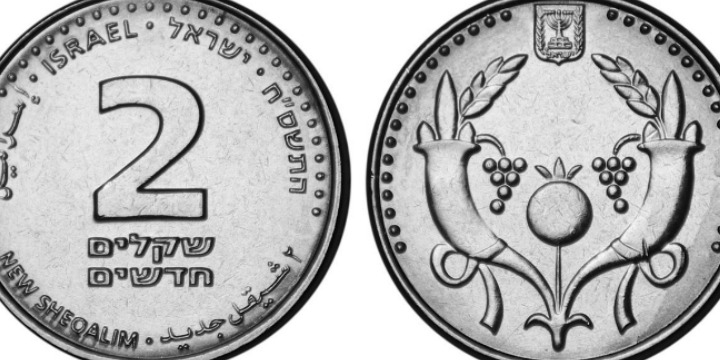First Temple Period Two Shekel Weight Discovered in Jerusalem’s Old City
 by i24 News
by i24 News
i24News – Archaeologists working on an excavation project in Jerusalem’s Old City recently discovered a 2,700-year old limestone weight, which approximately correlated to the known weight of two shekels.
The weight – which derives from the Iron Age and coincides with the First Temple period – was retrieved during sifting of earthen fills from the City of David sifting project; conducted under the auspices of the Israel Antiquities Authority and in conjunction with the Western Wall Heritage Foundation beneath Wilson’s Arch.
According to Dr Barak Monnickendam-Givon and Tehillah Lieberman, directors of the excavation on behalf of the Israel Antiquities Authority: “The weight is dome-shaped with a flat base. On the top of the weight is an incised Egyptian symbol resembling a Greek gamma (γ), representing the abbreviated unit ‘shekel.’ This weight weighs 23 grams and we know from earlier finds in Jerusalem that a single weight weighed 11.5 grams.”
Using accurate weights was important for business during the First Temple period as coins were still not in use. At busy times of the year, such as the three pilgrim festivals (Passover, Shavuot and Sukkot) when Jerusalem would be full of people, being able to rely on an exact weight ensured that a system of barter and exchange continued to function.
Several stone rows of the Western Wall were exposed during previous archaeological excavations under Wilson’s Arch. The stones had been covered with earthen fills for some 1,800 years.
 Police Stop Anti-Zionist Agitators From Accessing Florida University President’s Home as Students Revolt Nationwide
Police Stop Anti-Zionist Agitators From Accessing Florida University President’s Home as Students Revolt Nationwide Nearly One in Five Young People Sympathize With Hamas, 29% Say US Should Reduce or End Alliance With Israel: Poll
Nearly One in Five Young People Sympathize With Hamas, 29% Say US Should Reduce or End Alliance With Israel: Poll Ilhan Omar Silent After Daughter’s Arrest, Suspension for Role in Columbia University Anti-Israel Protest
Ilhan Omar Silent After Daughter’s Arrest, Suspension for Role in Columbia University Anti-Israel Protest Cultural Center Backed by Iran’s Revolutionary Guard Plans to Produce Films About Attack on Israel
Cultural Center Backed by Iran’s Revolutionary Guard Plans to Produce Films About Attack on Israel How Does Ilhan Omar Really Feel About Iran?
How Does Ilhan Omar Really Feel About Iran? This Passover, Combine Respect for Tradition with the Courage to Innovate
This Passover, Combine Respect for Tradition with the Courage to Innovate Israel’s Iran Attack Carefully Calibrated After Internal Splits, US Pressure
Israel’s Iran Attack Carefully Calibrated After Internal Splits, US Pressure Palestinian Cameramen Exposed in New Footage Documenting Oct. 7 Atrocities Side by Side with Terrorists
Palestinian Cameramen Exposed in New Footage Documenting Oct. 7 Atrocities Side by Side with Terrorists US Money to Convicted Terrorists; US Training to Aspiring Terrorists
US Money to Convicted Terrorists; US Training to Aspiring Terrorists Man Arrested in Paris After Iran Consulate Incident
Man Arrested in Paris After Iran Consulate Incident




 How Does Ilhan Omar Really Feel About Iran?
How Does Ilhan Omar Really Feel About Iran? Cultural Center Backed by Iran’s Revolutionary Guard Plans to Produce Films About Attack on Israel
Cultural Center Backed by Iran’s Revolutionary Guard Plans to Produce Films About Attack on Israel Ilhan Omar Silent After Daughter’s Arrest, Suspension for Role in Columbia University Anti-Israel Protest
Ilhan Omar Silent After Daughter’s Arrest, Suspension for Role in Columbia University Anti-Israel Protest Tehran Signals No Retaliation Against Israel After Drones Attack Iran
Tehran Signals No Retaliation Against Israel After Drones Attack Iran Nearly One in Five Young People Sympathize With Hamas, 29% Say US Should Reduce or End Alliance With Israel: Poll
Nearly One in Five Young People Sympathize With Hamas, 29% Say US Should Reduce or End Alliance With Israel: Poll